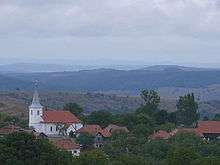Țara Călatei

Țara Călatei (Hungarian: Kalotaszeg) is a region in Transylvania, Romania. It is one of the few areas in Western Romania with a significant Hungarian population, and it is a stronghold of old Transylvanian Hungarian folk traditions.
Geography
Țara Călatei is a rural region situated just west of Cluj-Napoca in the western part of Cluj County and in the southern part of Sălaj County. Its historical center is the small town of Huedin. The region has an ethnically mixed population: Romanians, Hungarians and Roma. Its Jewish population suffered heavily during the Second World War.
Name
The region takes its name from the Călata people. The name formerly referred to a much larger territory; according to Lajos Kelemen's study on the history and historical monuments of the Țara Călatei region, during the Middle Ages the area reached from the Barcău River to the Crişul Repede River. The region as it is known today lies mainly west of Cluj-Napoca, although there are also some villages to the north and east as well which follow Kalotaszeg customs.
Țara Călatei in popular culture
The region was featured in the film Kalotaszegi Madonna ("Madonna from Țara Călatei", 1943), made in Northern Transylvania, when it was a part Kingdom of Hungary (1920–1946) between 1940-1944. The plot revolves around the region and the city of Cluj-Napoca, but some of the scenes were shot in the region as well.
Gallery
-

Hungarian church of Văleni village
-

Romanian church of Agârbiciu, built during the 17th century
-

Traditional Hungarian costumes from Izvoru Crişului
-

Romanian church of Fildu de Sus (in Sălaj County) built during the 18th century.
External links
Coordinates: 46°48′00″N 23°08′00″E / 46.8000°N 23.1333°E